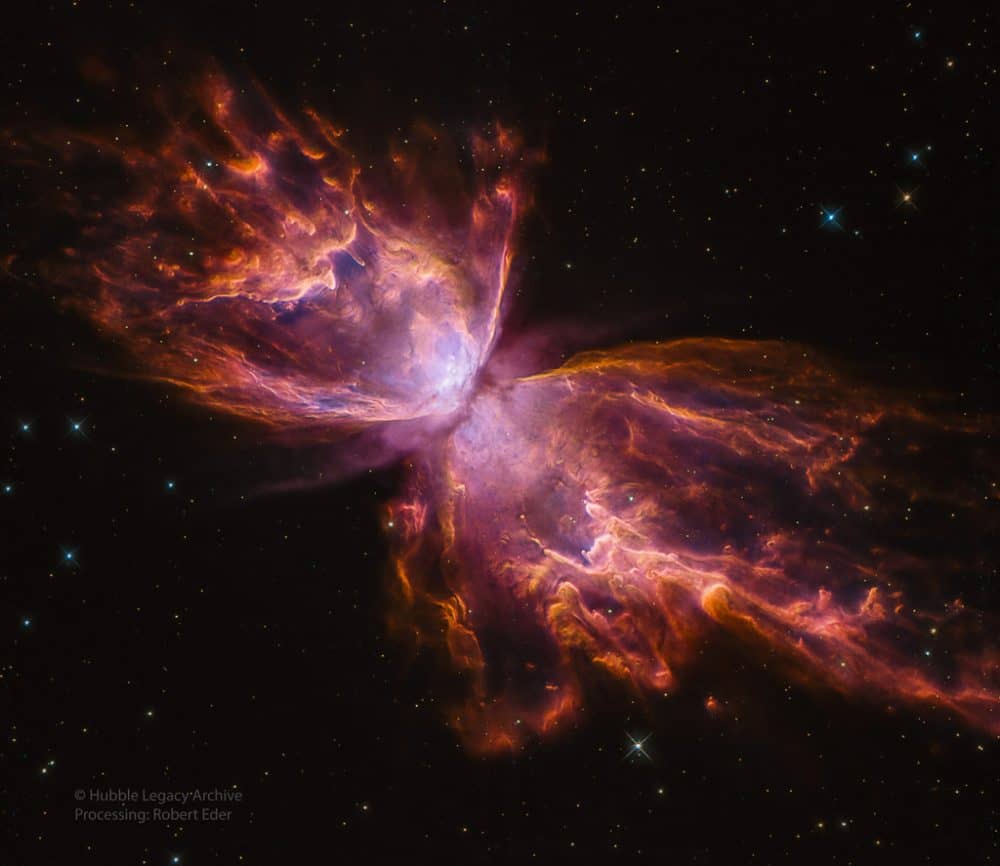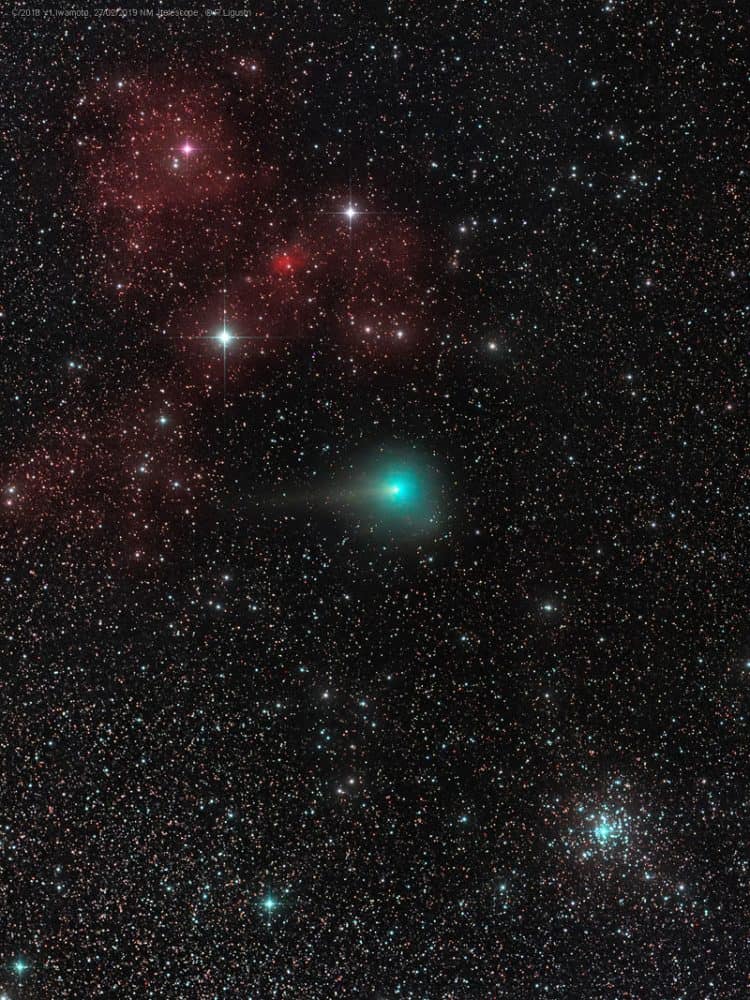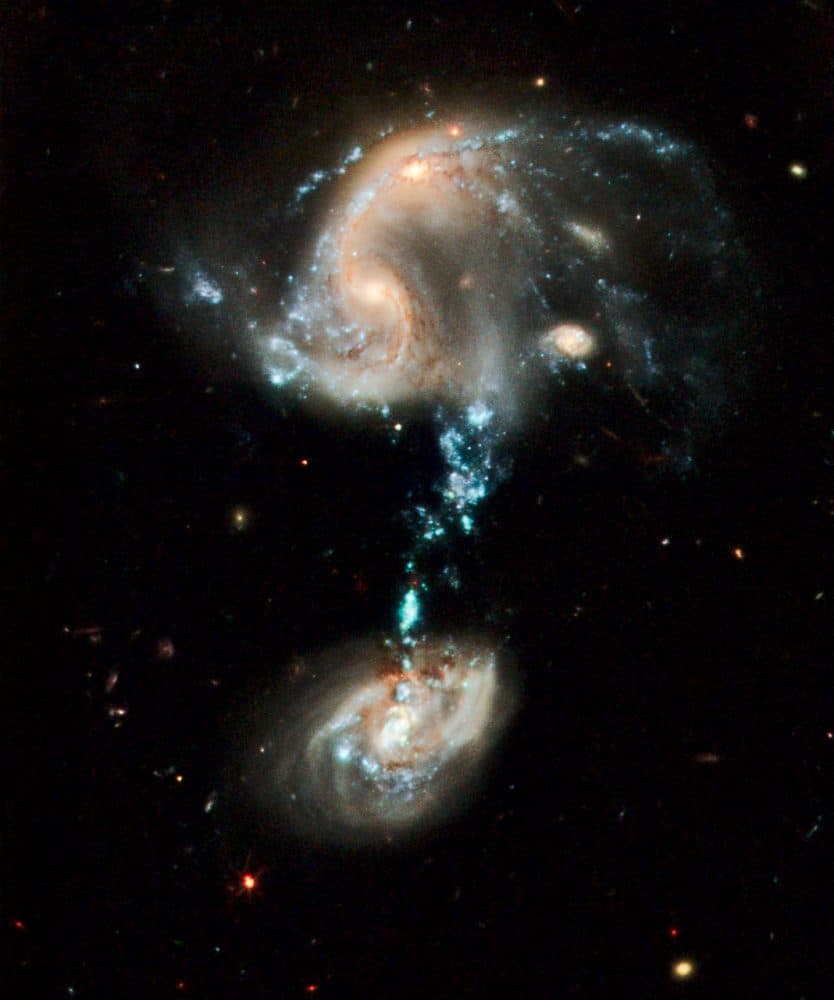Blog
The bright clusters and nebulae of planet Earth’s night sky are often named for flowers or insects. Though its wingspan covers over 3 light-years, NGC 6302 is no exception. With an estimated surface temperature of about 250,000 degrees C, the dying central star of this particular planetary nebula has become exceptionally hot, shining brightly in ultraviolet light but hidden from direct view by a dense torus of dust. This sharp close-up was recorded by the Hubble Space Telescope in 2009. The Hubble image data is reprocessed here, showing off the remarkable details of the complex planetary nebula. Cutting across a bright cavity of ionized gas, the dust torus surrounding the central star is near the center of this view, almost edge-on to the line-of-sight. Molecular hydrogen has been detected in the hot star’s dusty cosmic shroud. NGC 6302 lies about 4,000 light-years away in the arachnologically correct constellation of the Scorpion (Scorpius).
more...Larry Eugene Carlton (born March 2, 1948) is an American guitarist who built his career as a studio musician in the 1970s and ’80s for acts such as Steely Dan and Joni Mitchell. He has participated in thousands of recording sessions, recorded on hundreds of albums in many genres, for television and movies, and on more than 100 gold records. He has been a member of the jazz fusion groups The Crusaders and Fourplay and has maintained a long solo career.
Carlton was born in Torrance, California in 1948 and at the age of six began guitar lessons. His interest in jazz came from hearing guitarist Joe Pass on the radio. From Pass he moved on to jazz guitarists Barney Kessel and Wes Montgomery and blues guitarist B.B. King. He went to junior college and Long Beach State College while playing professionally at clubs in Los Angeles.
more...
Lewis Allan Reed (March 2, 1942 – October 27, 2013) was an American musician, singer and songwriter. He was the lead guitarist, singer and principal songwriter for the rock band the Velvet Underground and also had a solo career that spanned five decades. The Velvet Underground were not a commercial success during their existence, but are now regarded as one of the most influential bands in the history of underground and alternative rock music.
After leaving the band in 1970, Reed released twenty solo studio albums. His second, Transformer (1972), was produced by David Bowie and arranged by Mick Ronson, and brought mainstream recognition. After Transformer, the less commercial Berlin reached No. 7 on the UK Albums Chart. Rock n Roll Animal (a live album released in 1974) sold strongly, and Sally Can’t Dance (1974) peaked at No. 10 on the Billboard 200; but for a long period after, Reed’s work did not translate into sales, leading him deeper into drug addiction and alcoholism. Reed cleaned up in the early 1980s, and gradually returned to prominence with New Sensations (1984), reaching a critical and commercial career peak with his 1989 album New York.
Reed participated in the reformation of the Velvet Underground in the 1990s, and made several more albums, including a collaboration album with John Cale titled Songs for Drella which was a tribute to their former mentor Andy Warhol. 1992’s Magic and Loss, would become Reed’s highest-charting album on the UK Albums Chart, peaking at No. 6.
He contributed music to two theatrical interpretations of 19th century writers, one of which he developed into an album titled The Raven. He married his third wife Laurie Anderson in 2008, and recorded the collaboration album Lulu with Metallica. He died in 2013 of liver disease. Reed’s distinctive deadpan voice, poetic lyrics and experimental guitar playing were trademarks throughout his long career.
more...Edward F. Davis (March 2, 1922 – November 3, 1986), known professionally as Eddie “Lockjaw” Davis, was an American jazz tenor saxophonist.
Davis played with Cootie Williams, Lucky Millinder, Andy Kirk, Eddie Bonnemere, Louis Armstrong, and Count Basie, as well as leading his own bands and making many recordings as a leader. He played in the swing, bop, hard bop, Latin jazz, and soul jazz genres. Some of his recordings from the 1940s also could be classified as rhythm and blues.
His 1946 band, Eddie Davis and His Beboppers, featured Fats Navarro, Al Haig, Huey Long, Gene Ramey and Denzil Best.
In the 1950s, he was playing with Sonny Stitt, while from 1960 to 1962, he and fellow tenor saxophonist Johnny Griffin led a quintet. From the mid-1960s, Davis and Griffin also performed together as part of The Kenny Clarke-Francy Boland Big Band, along with other, mainly European, jazz musicians.
https://www.youtube.com/watch?v=Jn1Iy478ems
more...Still racing across planet Earth’s night skies, Comet Iwamoto (C/2018 Y1) shares this pretty telescopic field of view with stars and nebulae of northern constellation Auriga, the Charioteer. Captured onFebruary 27, Iwamoto’s greenish coma and faint tail appear between a complex of reddish emission nebulae and open star cluster M36 (bottom right). The reddish emission is light from hydrogen gas ionized by ultraviolet radiation from hot stars near the region’s giant molecular cloud some 6,000 light-years distant. The greenish glow from the comet, less than 5 light-minutes away, is predominantly emission from diatomic carbon molecules fluorescing in sunlight. M36, one of Auriga’s more familiar star clusters, is also a background object far beyond the Solar System, about 4,000 light-years away. Comet Iwamoto passed closest to Earth on February 12 and is outward bound in a highly elliptical orbit that will carry it beyond the Kuiper belt. With an estimated orbital period of 1,317 years it should return to the inner Solar System in 3390 AD.
more...Ralph Towner (born March 1, 1940, Chehalis, Washington) is an American multi-instrumentalist, composer, arranger and bandleader. He plays the twelve-string guitar, classical guitar, piano, synthesizer, percussion and trumpet.
Born in 1940 in Chehalis, Washington, Towner has made notable recordings of jazz, third stream under strong influence of folk and world music. He began his career as a conservatory-trained classical pianist, who picked up guitar in his senior year in college, then joined world music pioneer Paul Winter‘s “Consort” ensemble in the late 1960s. Along with bandmates Paul McCandless, Glen Moore, and Collin Walcott, Towner left the Winter Consort in 1970 to form the group Oregon, which over the course of the 1970s issued a number of highly influential records mixing folk music, Indian classical forms, and avant-garde jazz-influenced free improvisation. At the same time, Towner began a longstanding relationship with the influential ECMrecord label, which has released virtually all of his non-Oregon recordings since his 1972 debut as a leader Trios / Solos. Towner has also made numerous appearances as a sideman, perhaps most famously on jazz fusion heavyweights Weather Report‘s 1972 album I Sing the Body Electric.
Towner eschews amplification, using only 6-string nylon-string and 12-string steel-string guitars. As a result, he tends to avoid high-volume musical environments, preferring small groups of mostly acoustic instruments that emphasize dynamics and group interplay. Towner also obtains a percussive effect (e.g., “Donkey Jamboree” from Slide Show with Gary Burton) from the guitar by weaving a matchbook among the strings at the neck of the instrument. Both with Oregon and as a solo artist, Towner has made significant use of overdubbing, allowing him to play piano (or synthesizer) and guitar on the same track; his most notable use of the technique came on his 1974 album Diary, in which he plays guitar-piano duets with himself on most of the album’s 8 tracks. In the 1980s, Towner began using the Sequential Circuits Prophet-5 synthesizer fairly extensively, but has since deemphasized his synthesizer and piano playing in favor of guitar.
more...Benny Powell (March 1, 1930 – June 26, 2010) was an African-American jazz trombonist. He played both standard (tenor) trombone and bass trombone.
After leaving Basie, he freelanced in New York City. From 1966 to 1970 he was a member of the Thad Jones–Mel Lewis Jazz Orchestra, playing on Monday nights at the Village Vanguard. Among other engagements, he played in the house band of the Merv Griffin Show, and when the show moved to Los Angeles, California, in 1970 Powell also relocated there. He did extensive work as a session musician, including with Abdullah Ibrahim, John Carter, and Randy Weston. Later in his career Powell worked as an educator, including as part of the Jazzmobile project. Having moved back to New York in the 1980s, he began teaching at the New School for Jazz and Contemporary Music in 1994.
He died in a Manhattan hospital at the age of 80, following back surgery.
more...World Music on Flamenco Fridays featuring Soleá por Bulerías
A hybrid form of the two palos it names. It has the same compás and lyric form as the Soleá, but faster and with a stronger rhythm, reminiscent of the Bulerías. The compás is 12/8, with standard accents as shown

Also sometimes called Bulerías por soleá, Bulería al golpe or Bulería para escuchar, these names, although less common, may be more accurate as it could be argued that the song style is more influenced by the Bulería than the Soleá. A great palo for dancers, it portrays the depth of Flamenco without the sombre stateliness of the Soleá, while also providing a strong rhythmic base to introduce personality into the piece. As with the >Soleá, the structure is traditional:
– Guitar intro
– Song intro
– Footwork intro
– One or two letras (song verses). One of these may be followed by a guitar falsetta. Each will be followed by a footwork transition
– Subida (speed up)
– Escobilla footwork section, accompanied by traditional guitar arpeggio pattern
– Subida
– Bulerías to close
UGC 6093 is something known as a barred spiral galaxy — it has beautiful arms that swirl outwards from a bar slicing through the galaxy’s centre. It is classified as an active galaxy, which means that it hosts an active galactic nucleus, or AGN: a compact region at a galaxy’s centre within which material is dragged towards a supermassive black hole. As this black hole devours the surrounding matter it emits intense radiation, causing it to shine brightly.
But UGC 6093 is more exotic still. The galaxy essentially acts as a giant astronomical laser that spews out light at microwave, not visible, wavelengths — this type of object is dubbed a megamaser (maser being the term for a microwave laser). Megamasers such as UGC 6093 can be some 100 million times brighter than masers found in galaxies like the Milky Way.
more...Lewis Brian Hopkin Jones (28 February 1942 – 3 July 1969) was an English musician, best known as the founder and the original leader of the Rolling Stones. Initially a slide guitarist, Jones would go on to play a wide variety of instruments on Rolling Stones recordings and in concerts, such as rhythm and lead guitar, slide guitar, upright bass, sitar, dulcimer, various keyboard instruments such as piano and mellotron, marimba, harmonica, wind instruments such as recorder, saxophone, drums and numerous others.
Jones and fellow guitarist Keith Richards developed a unique style of guitar play that Richards refers to as the “ancient art of weaving” where both players would play rhythm and lead parts together; Richards would carry the style on with later Stones guitarists and the sound would become a Rolling Stones trademark.
After he founded the Rolling Stones as a British blues outfit in 1962, and gave the band its name, Jones’ fellow band members Mick Jagger and Keith Richards began to take over the band’s musical direction, especially after they became a successful songwriting team. Jones also did not get along with the band’s manager, Andrew Loog Oldham, who pushed the band into a musical direction at odds with Jones’ blues background. At the same time, Jones developed alcohol and drugs problems, and his performance in the studio became increasingly unreliable, leading to a diminished role within the band he had founded. In June 1969, the Rolling Stones asked Jones to leave; guitarist Mick Taylor took his place in the group. Jones died less than a month later, drowning in the swimming pool at his home while under the influence of alcohol and drugs.
Long-time Rolling Stones bass guitarist Bill Wyman said of Jones, “He formed the band. He chose the members. He named the band. He chose the music we played. He got us gigs. … he was very influential, very important, and then slowly lost it – highly intelligent – and just kind of wasted it and blew it all away.
more...John Aloysius Fahey (/ˈfæhi/; February 28, 1939 – February 22, 2001) was an American fingerstyle guitarist and composer who played the steel-string acoustic guitar as a solo instrument. His style has been greatly influential and has been described as the foundation of American Primitive Guitar, a term borrowed from painting and referring mainly to the self-taught nature of the music and its minimalist style. Fahey borrowed from the folk and blues traditions in American roots music, having compiled many forgotten early recordings in these genres. He would later incorporate 20th-century classical, Portuguese, Brazilian, and Indian influences into his work.
He spent many of his later years in poverty and poor health, but enjoyed a minor career resurgence with a turn towards the avant-garde. He also created a series of abstract paintings in his final years. Fahey died in 2001 from complications from heart surgery. In 2003, he was ranked 35th on Rolling Stone magazine’s “100 Greatest Guitarists of All Time” list.
Fahey was born into a musical household in Washington, D.C. in 1939. Both his father, Aloysius John Fahey, and his mother, Jane (née Cooper), played the piano. In 1945, the family moved to the Washington suburb of Takoma Park, Maryland, where his father lived until his death in 1994. On weekends, the family attended performances of the top country and bluegrassacts of the day, but it was hearing Bill Monroe‘s version of Jimmie Rodgers‘ “Blue Yodel No. 7” on the radio that ignited the young Fahey’s passion for music.
In 1952, after being impressed by guitarist Frank Hovington, whom he met while on a fishing trip, he purchased his first guitar for $17 from a Sears, Roebuck catalogue. Along with his budding interest in the guitar, Fahey was attracted to record-collecting. While his tastes ran mainly in the bluegrass and country vein, Fahey discovered his love of early blues upon hearing Blind Willie Johnson‘s “Praise God I’m Satisfied” on a record-collecting trip to Baltimore with his friend and mentor, the musicologist Richard K. Spottswood. Much later, Fahey compared the experience to a religious conversion; he remained a devout disciple of the blues for the rest of his life.
more...Willie Bobo was the stage name of William Correa (February 28, 1934 – September 15, 1983), a Latin and jazz percussionist of Puerto Rican ancestry.
William Correa grew up in Spanish Harlem, New York City. He made his name in Latin Jazz, specifically Afro-Cuban jazz, in the 1960s and 1970s, with the timbales becoming his favoured instrument. He met Mongo Santamaría shortly after his arrival in New York and studied with him while acting as his translator, and later at the age of 19 joined Tito Puente for four years.
The nickname Bobo is said to have been bestowed by the jazz pianist Mary Lou Williams in the early 1950s.
His first major exposure was when he joined George Shearing‘s band on the album The Shearing Spell. After leaving Shearing, Cal Tjader asked Bobo and Santamaría to become part of the Cal Tjader Modern Mambo Quintet, who released several albums as the mambo craze reached fever pitch in the late ’50s. Reuniting with his mentor Santamaría in 1960, the pair released the album Sabroso! for the Fantasy label. Bobo later formed his own group, releasing Do That Thing/Guajira with Tico and Bobo’s Beat and Let’s Go Bobo for Roulette, without achieving huge penetration.
more...Arp 194 comprises a group of galaxies of which at least two are in the process of merging. The merging galaxies, seen in the upper portion of the image, display two bright galactic cores that shine with the yellow light of aging stars. These galaxies have been greatly distorted by their mutual gravitational interaction as can be seen in the dusty, chaotic, spiral features. The smaller bright galaxy to the right of the merging pair is in the background and is not involved in the merger. Perhaps the most striking feature of the merger is the fountain of brilliant, newly formed, star clusters extending from the southern, or lower, portion of the merging galaxies. This string of star cluster seems to be connected to the large galaxy in the lower part of the image. This galaxy, however, is located behind the two merging galaxies. It is unclear if this galaxy actually contributed to the interaction of the merger.
The Arp 194 merger is taking place approximately 600 million light years distant and is located in the constellation of Ursa Major.
This image was assembled with data obtained from the Hubble Legacy Archive. Three filtered images were used for the red, green and blue channels. These were imaged using filters of f815w for red, f555w for green and f450w for blue. A luminance channel was created by combining the three filtered images. The color image was created as a standard LRGB image.
more...
Dexter Gordon (February 27, 1923 – April 25, 1990 LA,CA) was an American jazz tenor saxophonist. He was one of the first players of the instrument in the bebop idiom of musicians such as Charlie Parker, Dizzy Gillespie, and Bud Powell. Gordon’s height was 6 feet 6 inches (198 cm), so he was also known as “Long Tall Dexter” and “Sophisticated Giant”. His studio and performance career spanned over 40 years.
Gordon’s sound was commonly characterized as being “large” and spacious and he had a tendency to play behind the beat. He was known for humorously inserting musical quotes into his solos, with sources as diverse as popular tunes, “Happy Birthday”, and the operas of Wagner. This is not unusual in common-practice jazz improvisation, but Gordon did it frequently enough to make it a hallmark of his style. One of his major influences was Lester Young. Gordon, in turn, was an early influence on John Coltrane and Sonny Rollins. Rollins and Coltrane then influenced Gordon’s playing as he explored hard bop and modal playing during the 1960s.
Gordon was known for his genial and humorous stage presence. He was an advocate of playing to communicate with the audience. A photograph by Herman Leonard of Gordon taking a smoke break at the Royal Roost in 1948 is one of the iconic images in jazz photography. Cigarettes were a recurring theme on covers of Gordon’s albums. One of his idiosyncratic rituals was to recite lyrics from each ballad before playing it.
Gordon was nominated for an Academy Award for Best Actor in a Leading Role for his performance in the Bertrand Tavernier film Round Midnight (Warner Bros, 1986), and he won a Grammy for Best Jazz Instrumental Performance, Soloist, for the soundtrack album The Other Side of Round Midnight (Blue Note Records, 1986). He also had a cameo role in the 1990 movie Awakenings.
more...More Posts
- Mary Lou Williams Day
- World Music with Omara “Bombino” Moctar
- Daily Roots with Leroy Sibbles
- World Music with Sivan Perwer
- The Cosmos with NGC 3372
- Joe Ford Day
- Bumble Bee Slim Day
- Pyotr Ilyich Tchaikovsky Day
- Daily Roots with Peter Austin & the Clarendonians
- Dror Sinai Dumbeck Workshop 5-6-19
- The Cosmos with NGC 7674
- Lolita Flores Day
- David Friesen Day
- World Music with Massa Dembele
- Daily Roots with Johnny Moore
- POSITIVE VIBRATIONS performing at Mayday 6pm
- BEAU KOO JACKS performing at Mayday 5pm
- The 45th Annual MAYDAY Parade, Ceremony and Festival
- The Cosmos with NGC 4244
- Adele Day



